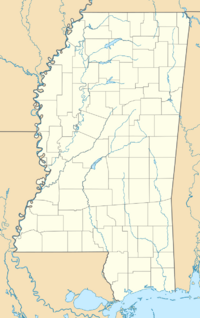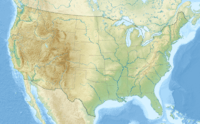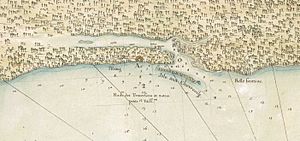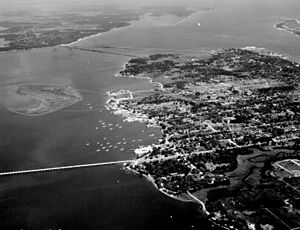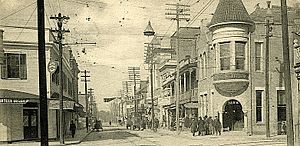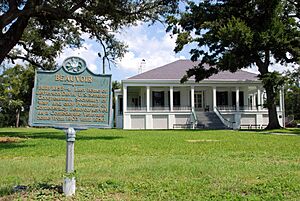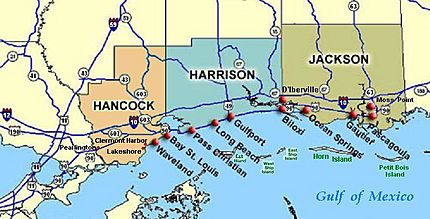Biloxi, Mississippi facts for kids
Quick facts for kids
Biloxi, Mississippi
|
|||
|---|---|---|---|
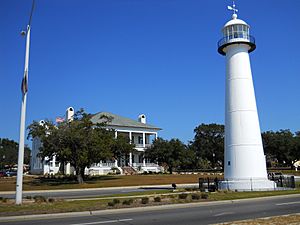
The Biloxi Visitors Center and the Biloxi Lighthouse, the city's signature landmark, in November 2011
|
|||
|
|||

Location in Harrison County and the state of Mississippi
|
|||
| Country | |||
| State | |||
| County | Harrison | ||
| Incorporated | in 1838 as a township | ||
| Area | |||
| • City | 67.71 sq mi (175.36 km2) | ||
| • Land | 42.94 sq mi (111.20 km2) | ||
| • Water | 24.77 sq mi (64.16 km2) | ||
| Elevation | 20 ft (6 m) | ||
| Population
(2020)
|
|||
| • City | 49,449 | ||
| • Density | 1,151.69/sq mi (444.67/km2) | ||
| • Metro | 416,259 (US: 133rd) | ||
| Time zone | UTC−6 (CST) | ||
| • Summer (DST) | UTC−5 (CDT) | ||
| ZIP Codes |
39530–39535, 39540
|
||
| Area code(s) | 228 | ||
| FIPS code | 28-06220 | ||
| GNIS feature ID | 0667173 | ||
Biloxi (pronounced bih-LUK-see) is a city in Harrison County, Mississippi, United States. It's located on the Gulf Coast in southern Mississippi. Biloxi is next to Gulfport, and both cities are important centers for Harrison County. In 2020, Biloxi had about 49,449 people, making it the fourth-largest city in Mississippi. It's also a main city in the larger Gulfport–Biloxi area, which has over 416,000 residents. The first Europeans to settle here were French colonists.
Biloxi's beachfront is right on the Mississippi Sound. There are many barrier islands just off the coast in the Gulf of America. Keesler Air Force Base, a major U.S. Air Force base, is located within the city.
Contents
History of Biloxi
Early Settlements
In 1699, French explorers created the first lasting European settlement in French Louisiana. This was at Fort Maurepas, which is now in Ocean Springs, Mississippi. People sometimes called this place "Old Biloxi." It was led by Pierre Le Moyne d'Iberville.
The name "Biloxi" comes from the local Native American tribe. In their language, it was a word that the French wrote as Bilocci.
In 1720, the area where Biloxi is today was settled for the first time around Fort Louis. The main government center for French Louisiana was moved to Biloxi from Mobile. This French colony was called La Louisiane.
Because of worries about high tides and hurricanes, the governor, Bienville, moved the capital of French Louisiana in 1722. He moved it from Biloxi to a new city built inland, which was called La Nouvelle-Orléans (New Orleans).
In 1763, after Britain won a big war, France had to give up its colonies east of the Mississippi River to Great Britain. This included Biloxi. At the same time, France gave its colonies west of the Mississippi, plus New Orleans, to Spain.
Later Years
British rule lasted from 1763 to 1779. Then, Spain ruled from 1779 to 1810. Even with these changes, Biloxi mostly kept its French feel, as many French descendants lived there. In 1811, the U.S. took control of Biloxi from Spain. Mississippi, including Biloxi, became a U.S. state in 1817.
Biloxi started to grow. In the 1800s, it became a popular summer vacation spot. People liked its cool breezes and beaches. It was also close to New Orleans and easy to reach by water. Wealthy families built summer homes, and hotels and rental cottages were built for visitors.
The Biloxi Lighthouse was built in 1848. It was made in Baltimore, Maryland, and then shipped to Biloxi. It is one of only two lighthouses left on the Mississippi Gulf Coast.
During the American Civil War, Ship Island was taken by Union forces, which helped them control Biloxi. No big battles happened in Biloxi itself, so the city was not directly damaged.
After the war, Biloxi became a popular vacation spot again. Its popularity grew even more when railroads made it easier to get there. In 1881, the first factory to process seafood was built in Biloxi. This led to more factories and brought new people from Europe to work in the seafood industry. These changes made Biloxi a more diverse city.
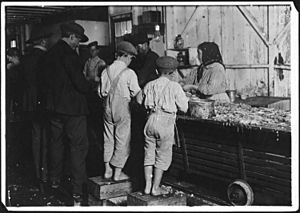
During World War II, the United States Army Air Forces built Keesler Field, which is now Keesler Air Force Base. It became a big training center and place for aircraft repair. Biloxi's economy grew a lot because of this, bringing in new people and businesses.
Biloxi has a history with casinos going back to the 1940s. These were not always legal, but they were there. In the 1950s, open gambling stopped. The Mississippi Gulf Coast became known as a place for families to go fishing in the summer. Biloxi was famous for its shrimp and oyster boats. The tradition of "Blessing of the Fleet," where fishing boats are blessed for a safe season, started in Biloxi in 1929 and still happens today.
In 1959, Biloxi was important in the fight for civil rights. A Black doctor named Gilbert R. Mason and his friends tried to swim at a local beach but were told to leave because of their race. Dr. Mason led protests, known as the Biloxi Wade-Ins. These protests eventually led to the beaches of Biloxi being open to everyone, regardless of race.
In the early 1960s, the Gulf Coast became a popular vacation spot again for people from the Northern United States. Biloxi was a favorite place. Hotels improved their services and hired top chefs to offer amazing seafood.
When gambling became legal in Mississippi in the 1990s, Biloxi changed again. It became a major center for resort casinos. These new hotels and casinos brought a lot of money from tourism to the city. Famous casino resorts include the Beau Rivage, Hard Rock Hotel and Casino, and Imperial Palace. Biloxi became a top gambling and entertainment spot in the Southern United States.
Hurricanes in Biloxi
Many hurricanes have hit the Mississippi Gulf Coast. Some of the most powerful ones, measured by how high the water rose at the Biloxi Lighthouse, happened in 1855, 1906, 1909, 1947, 1969 (Hurricane Camille), and 2005 (Hurricane Katrina).
On August 29, 2005, Hurricane Katrina struck the Mississippi Gulf Coast. It brought strong winds, heavy rains, and a huge storm surge of about 30 feet (9 meters). This caused massive damage to the area. The mayor of Biloxi, A. J. Holloway, said it was "our tsunami." The governor of Mississippi compared the destruction to an American Hiroshima.
Hurricane Katrina badly damaged many libraries in Mississippi, including the Biloxi Public Library, which had to be completely rebuilt.
Biloxi has a memorial to the victims of Katrina. It was made by local artists with help from the TV show Extreme Makeover: Home Edition. After the hurricane, many plans were made to rebuild the waterfront. The city has been working quickly to allow new businesses to be built in the damaged areas.
Geography of Biloxi
Biloxi is in the southeastern part of Harrison County. To the south is the Mississippi Sound, which is part of the Gulf of Mexico. To the northeast, across Biloxi Bay, are the cities of Ocean Springs and St. Martin. The Back Bay of Biloxi goes west through the city. The Tchoutacabouffa River flows across the city and forms part of its eastern border. Biloxi is bordered by D'Iberville to the north and east, and Gulfport to the west.
The United States Census Bureau says Biloxi covers about 120.9 square kilometers (46.7 square miles). About 99.0 square kilometers (38.2 square miles) is land, and 21.9 square kilometers (8.5 square miles), or 18.14%, is water.
Biloxi has a humid subtropical climate. This means it has mild, wet winters and hot, humid summers. Snow is very rare. Tropical storms can hit the area from late summer to fall. The coldest temperature ever recorded was 1°F (–17°C) in February 1899. The hottest was 104°F (40°C) in August 2000 and August 2023.
| Climate data for Biloxi, Mississippi (1991–2020 normals, extremes 1893–present) | |||||||||||||
|---|---|---|---|---|---|---|---|---|---|---|---|---|---|
| Month | Jan | Feb | Mar | Apr | May | Jun | Jul | Aug | Sep | Oct | Nov | Dec | Year |
| Record high °F (°C) | 82 (28) |
87 (31) |
89 (32) |
91 (33) |
98 (37) |
102 (39) |
103 (39) |
104 (40) |
101 (38) |
98 (37) |
88 (31) |
83 (28) |
104 (40) |
| Mean daily maximum °F (°C) | 59.8 (15.4) |
63.2 (17.3) |
69.3 (20.7) |
75.8 (24.3) |
82.8 (28.2) |
88.0 (31.1) |
89.7 (32.1) |
89.9 (32.2) |
86.9 (30.5) |
79.1 (26.2) |
69.2 (20.7) |
62.2 (16.8) |
76.3 (24.6) |
| Daily mean °F (°C) | 51.7 (10.9) |
55.2 (12.9) |
61.3 (16.3) |
68.1 (20.1) |
75.6 (24.2) |
80.9 (27.2) |
82.5 (28.1) |
82.5 (28.1) |
79.2 (26.2) |
70.5 (21.4) |
60.2 (15.7) |
54.0 (12.2) |
68.5 (20.3) |
| Mean daily minimum °F (°C) | 43.6 (6.4) |
47.3 (8.5) |
53.4 (11.9) |
60.4 (15.8) |
68.3 (20.2) |
73.8 (23.2) |
75.3 (24.1) |
75.1 (23.9) |
71.5 (21.9) |
61.9 (16.6) |
51.2 (10.7) |
45.9 (7.7) |
60.6 (15.9) |
| Record low °F (°C) | 10 (−12) |
1 (−17) |
22 (−6) |
30 (−1) |
42 (6) |
54 (12) |
60 (16) |
61 (16) |
44 (7) |
32 (0) |
24 (−4) |
9 (−13) |
1 (−17) |
| Average precipitation inches (mm) | 5.37 (136) |
4.37 (111) |
5.72 (145) |
5.65 (144) |
5.25 (133) |
7.13 (181) |
8.09 (205) |
6.93 (176) |
5.24 (133) |
3.68 (93) |
4.36 (111) |
5.03 (128) |
66.80 (1,697) |
| Average snowfall inches (cm) | 0.0 (0.0) |
0.0 (0.0) |
0.1 (0.25) |
0.0 (0.0) |
0.0 (0.0) |
0.0 (0.0) |
0.0 (0.0) |
0.0 (0.0) |
0.0 (0.0) |
0.0 (0.0) |
0.0 (0.0) |
0.0 (0.0) |
0.1 (0.25) |
| Average precipitation days (≥ 0.01 in) | 9.5 | 8.9 | 8.0 | 7.0 | 7.1 | 11.9 | 13.9 | 12.7 | 8.6 | 6.5 | 7.3 | 9.2 | 110.6 |
| Source: NOAA | |||||||||||||
People of Biloxi (Demographics)
| Historical population | |||
|---|---|---|---|
| Census | Pop. | %± | |
| 1870 | 954 | — | |
| 1880 | 1,540 | 61.4% | |
| 1890 | 3,234 | 110.0% | |
| 1900 | 5,457 | 68.7% | |
| 1910 | 8,049 | 47.5% | |
| 1920 | 10,937 | 35.9% | |
| 1930 | 14,850 | 35.8% | |
| 1940 | 17,475 | 17.7% | |
| 1950 | 37,425 | 114.2% | |
| 1960 | 44,035 | 17.7% | |
| 1970 | 48,486 | 10.1% | |
| 1980 | 49,311 | 1.7% | |
| 1990 | 46,319 | −6.1% | |
| 2000 | 50,644 | 9.3% | |
| 2010 | 44,054 | −13.0% | |
| 2020 | 49,449 | 12.2% | |
| U.S. Decennial Census 2018 Estimate |
|||
Biloxi is one of the two main cities in the Gulfport-Biloxi area. This area is part of a larger region called the Gulfport-Biloxi-Pascagoula Combined Statistical Area.
2020 Census Information
| Historical racial composition | 1970 | 1990 | 2000 | 2010 | 2019 est. |
|---|---|---|---|---|---|
| White | 85.6% | 74.6% | 60.0% | 58.0% | 65.0% |
| Black | 13.6% | 18.6% | 35.8% | 34.9% | 20.7% |
| Asian | 0.4% | 5.7% | 1.6% | 2.0% | 3.7% |
| Native | 0.1% | 0.3% | 0.3% | 0.4% | 0.4% |
| Native Hawaiian and other Pacific Islander |
- | - | 0.1% | 0.1% | 0.0% |
| Other race | 0.3% | 0.7% | 1.0% | 2.8% | 1.0% |
| Two or more races | - | – | 1.3% | 1.9% | 7.4% |
| Race / Ethnicity (NH = Non-Hispanic) | Pop 2000 | Pop 2010 | Pop 2020 | % 2000 | % 2010 | % 2020 |
|---|---|---|---|---|---|---|
| White alone (NH) | 35,292 | 28,402 | 28,771 | 69.69% | 64.47% | 58.18% |
| Black or African American alone (NH) | 9,569 | 8,491 | 10,779 | 18.89% | 19.27% | 21.80% |
| Native American or Alaska Native alone (NH) | 232 | 160 | 148 | 0.46% | 0.36% | 0.30% |
| Asian alone (NH) | 2,558 | 1,923 | 2,123 | 5.05% | 4.37% | 4.29% |
| Pacific Islander alone (NH) | 50 | 84 | 67 | 0.10% | 0.19% | 0.14% |
| Some Other Race alone (NH) | 75 | 68 | 208 | 0.15% | 0.15% | 0.42% |
| Mixed Race or Multi-Racial (NH) | 1,020 | 1,079 | 2,668 | 2.01% | 2.45% | 5.40% |
| Hispanic or Latino (any race) | 1,848 | 3,847 | 4,685 | 3.65% | 8.73% | 9.47% |
| Total | 50,644 | 44,054 | 49,449 | 100.00% | 100.00% | 100.00% |
In 2020, there were 49,449 people living in Biloxi. These people made up 17,923 households and 10,922 families.
Some places of worship in Biloxi include the Cathedral of the Nativity of the Blessed Virgin Mary and the First Baptist Church of Biloxi.
Economy of Biloxi
Biloxi is known for its eight casino resort hotels. These places offer entertainment, shows, and many restaurants. Many casinos were damaged or destroyed by Hurricane Katrina, but most have since reopened. Some of the current casino resorts are:
- Beau Rivage Resort & Casino (reopened in 2006)
- Golden Nugget Biloxi
- Hard Rock Hotel & Casino (opened in 2007)
- Harrah's Gulf Coast
- IP Casino Resort & Spa (reopened in 2005)
- Palace Casino Resort
- Boomtown Casino (reopened in 2006)
- Treasure Bay Casino
Arts and Culture
- In 2010, the new Frank Gehry-designed Ohr-O'Keefe Museum Of Art opened.
 The Ohr-O'Keefe Museum Of Art campus in Biloxi.
The Ohr-O'Keefe Museum Of Art campus in Biloxi. - Biloxi is the setting for Neil Simon's play and movie Biloxi Blues. This story is about army recruits training at Keesler Field during World War II.
- Several John Grisham novels, like The Runaway Jury and The Boys from Biloxi, are set in Biloxi.
- The song "Biloxi" by American singer-songwriter Jesse Winchester was inspired by the city.
- Jimmy Buffett also included a cover of "Biloxi" on his album Changes in Latitudes, Changes in Attitudes. He also released a greatest hits album called Biloxi.
- From 1990 to 1994, Biloxi hosted the Miss Teen USA Pageant.
- The tradition of the Blessing of the Fleet started in Biloxi in 1929. It happens every year in late May or early June before shrimp season. It's a way to wish for a safe and successful season for the fishing boats.
Sports in Biloxi
| Club | League | Sport | Venue | Founded | Affiliate |
|---|---|---|---|---|---|
| Biloxi Shuckers | SL | Baseball | Keesler Federal Park | 2015 | Milwaukee Brewers |
| Mississippi Sea Wolves | FPHL | Ice hockey | Mississippi Coast Coliseum | 2022 |
Biloxi is known for great sportsfishing in the northern Gulf of Mexico. You can catch fish like spotted seatrout, red drum, Spanish and king mackerel, flounder, snapper, grouper, and sharks.
The Biloxi Shuckers are a Double-A baseball team. They are part of the Southern League and are connected to the Milwaukee Brewers. They play at Keesler Federal Park.
The Mississippi Sea Wolves ice hockey team plays at the Mississippi Coast Coliseum. Biloxi also used to have other hockey teams.
Education
The city of Biloxi is served by two school districts: the Biloxi Public School District and the Harrison County School District. There are also many Catholic schools in the Gulf Coast area, with 15 of them in Biloxi.
Media
Biloxi has one daily newspaper, the Sun Herald, which is based in nearby Gulfport.
There are 20 FM and 7 AM radio stations that operate in or serve the Biloxi area.
According to Nielsen Media Research, Biloxi is the third-largest television market in Mississippi. Three main TV stations serve the Biloxi area: ABC and CBS affiliate WLOX 13, and PBS station WMAH-TV 19 are in Biloxi. The Fox and MyNetworkTV affiliate WXXV-TV 25 is in Gulfport.
Transportation
You can fly into Biloxi through the Gulfport-Biloxi International Airport in Gulfport.
The Coast Transit Authority provides bus service around the region.
Biloxi's main highway is U.S. Highway 90 (Beach Boulevard). It runs along the beach and past the casinos. It connects Biloxi to Gulfport to the west and to Ocean Springs and Pascagoula to the east. The Biloxi Bay Bridge, which connects Biloxi and Ocean Springs, was rebuilt after Hurricane Katrina and fully reopened in 2008.
Interstate 10 goes through the northern parts of the city. It leads west to New Orleans and east to Mobile, Alabama. Interstate 110 branches off from I-10 and goes south across the Back Bay of Biloxi to U.S. 90. This highway is an important route for people to leave the city safely during a hurricane.
Other highways in the area include:
- Mississippi Highway 15
- Mississippi Highway 67
Notable People from Biloxi
- Jessica Alba, model and actress, lived in Biloxi when her father was at Keesler Air Force Base.
- Laura Bailey, a voice actress.
- Matt Barlow, a heavy metal singer.
- Hector Camacho, a world champion boxer.
- Chris Carson, an NFL running back.
- Gary Collins, an actor and TV personality.
- Jefferson Davis, the only president of the Confederate States of America.
- Fred Haise, an astronaut from Apollo 13 and the Space Shuttle Enterprise.
- Ted Hawkins, a singer-songwriter.
- Mary Ann Mobley, an actress and former Miss America.
- George E. Ohr, a famous potter.
- Eric Roberts, an Oscar-nominated actor.
Filming Locations
Several movies have been filmed in Biloxi, including:
- Stone Cold (1991), starring Brian Bosworth.
- Mississippi Masala (1992), starring Denzel Washington.
- Arsenal (2017), starring Adrian Grenier, John Cusack, and Nicolas Cage.
- Vanquish (2021), starring Morgan Freeman and Ruby Rose.
Images for kids
-
U.S. Navy personnel perform a search and rescue mission in Biloxi after Hurricane Katrina.
-
Biloxi beach during cleanup of storm debris.
-
Front view of Beauvoir in Biloxi, 7 months after Hurricane Katrina.
See also
 In Spanish: Biloxi (Misisipi) para niños
In Spanish: Biloxi (Misisipi) para niños




